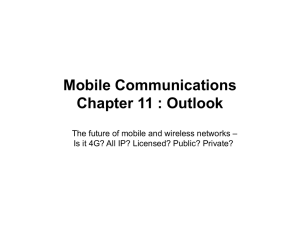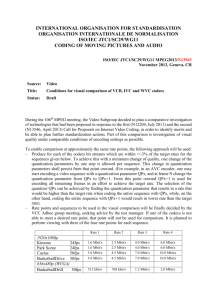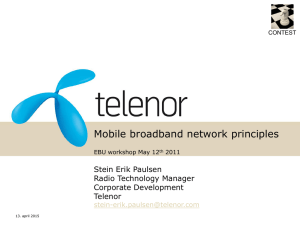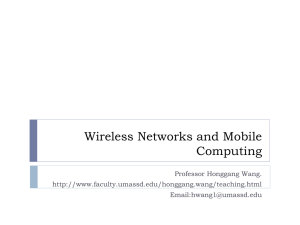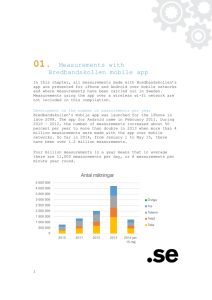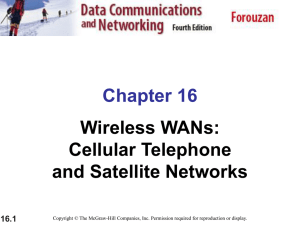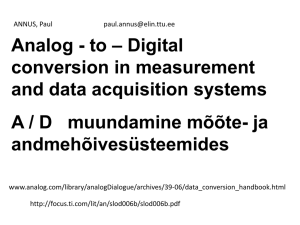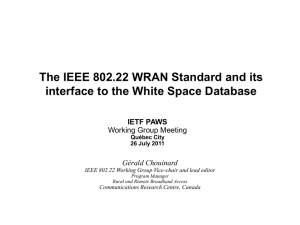Schill-lecture-09-09-2013
advertisement
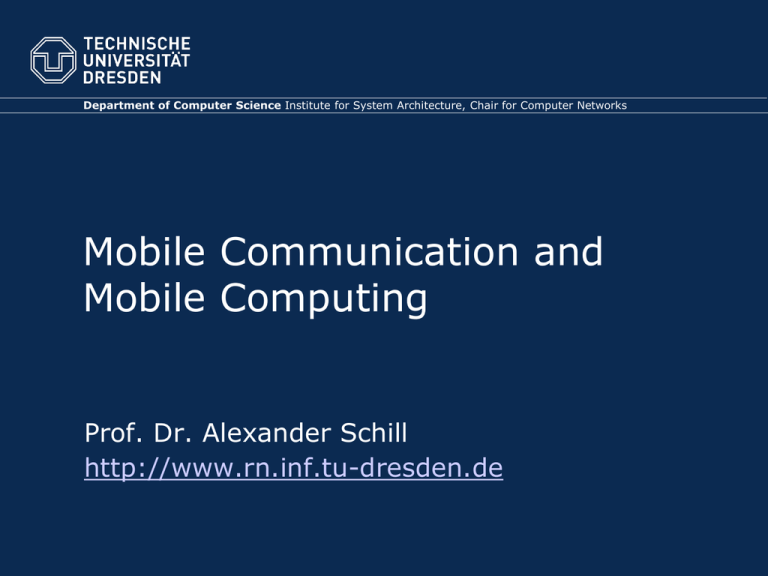
Department of Computer Science Institute for System Architecture, Chair for Computer Networks
Mobile Communication and
Mobile Computing
Prof. Dr. Alexander Schill
http://www.rn.inf.tu-dresden.de
Structure of the Lecture
Part I: Mobile Communication
-
Introduction and Principles
GSM, UMTS and LTE (2G-3G-4G Mobile Networks)
WiFi and Bluetooth
Satellite Systems and GPS
Part II: Mobile Computing
-
Mobile Web
Location Based Services
Mobile Platforms and Applications
2
Introduction and Principles
Applications like Civil Engineering
Enterprise A
(main office)
Gigabit
Ethernet
Large archives,
Videoconferences
Drafts,
urgent
modification
Gigabit Ethernet
Fast Ethernet
Enterprise A
(branch office)
Architect
Selected drafts,
Videoconferences
UMTS, LTE
Enterprise B
Construction
supervisor
Material data,
status data,
dates
GSM, UMTS
Building site
3
Example: Consumer Application
8:56PM
http://www.bike-rental...
Rent-A-Bike
Service Login
Login:
Alexander Schill
Password:
URL
**********
LOGIN
4
Mobile Communication: Development
Mobile
Phone
Networks
E (GSM1800)
D (GSM900)
C
HSCSD
EDGE
GPRS
Packet Networks
Modacom
Circuit
Switched
Networks
Mobitex
Tetra
Satellite
Networks
Cordless
Telephony
Local
Networks
IMT/
UMTS
4G
(LTE advanced,
WiMAX)
Iridium/
Globalstar
Inmarsat
CT
LTE
DECT
Radio-LAN
IR-LAN
1990
IEEE 802.11
Bluetooth
1995
2000
2005
2010
2015
5
Used Acronyms
C: C: Analog “C” Network (1st Generation)
CT: CT: Cordless Telephone
DECT: Digital Enhanced Cordless Telecommunications
DECT:
GSM: Global System for Mobile Communications (2nd Generation)
GSM:
GPRS: General Packet Radio Service
GPRS:
HSDPA+:
HSCSD:High Speed Downlink Packet Access (advanced)
HSUPA+: High Speed Uplink Packet Access (advanced)
HSCSD: High Speed Circuit Switched Data
EDGE: Enhanced Data Rates for GSM Evolution
EDGE:
IMT: International Mobile Telecommunications
IMT:
LTE: Long Term Evolution
LTE:
TETRA:
TETRA: Terrestrial Trunked Radio (Multicast Communication System)
UMTS: Universal Mobile Telecommunications System (3rd Generation)
UMTS:
4G:4G: 4th Generation Networks
WiMAX:
WiMAX Worldwide Interoperability for Microwave Access
6
Correspondent data rates
LTE
300 Mbit/s
(downlink)
200 Mbit/s
LTE (uplink) / HSDPA+
100 Mbit/s
50 Mbit/s
HSUPA+
10 Mbit/s
WLAN
1 Mbit/s
DECT
EDGE
HSCSD/
GPRS
100 kbit/s
10kbit/s
UMTS
(pico cell)
GSM
1995
UMTS
(macro cell)
Satellites
2000
2005
2010
2015
7
Cellular networks
• well known from mobile networks (GSM, UMTS)
• base station (BS) covers at least one cell; a combination
of multiple cells is also called a cellular structure
• provides different kinds of handovers between the cells
• higher capacity and better coverage than non-cellular
networks
• bidirectional* antennas instead of omni-directional** can
better serve the selected sectors
along highways
or train lines
for covering
of larger areas
*
**
8
Structure of a cellular network
1
4
2
1
3
1
4
3
2
1
• Major problems:
limited frequency
resources
interference
• reuse of frequency
channels in remote cells
• cluster of N cell types
• reuse distance
D
3N R
• where R – cell radius
9
FDMA (Frequency Division Multiple Access)
• frequencies are permanently assigned to transmission
channels (known from broadcast radio)
k1
k2
k3
k4
k5
k6
f
k6
k5
f1
f2
f3
s
FDMA selects
frequency
f4
f5
f6
k4
k3
k2
k1
t
s – secure distance
10
TDMA (Time Division Multiple Access)
• transmission medium is slot-assigned to channels for
certain time, is often used in LANs
• Synchronization (timing, static or dynamic) between
transmitting and receiving stations is required
k1
k2
TDMA selects
slot
k3
k4
k5
f1
k6
f
k1
k2
k3
k4
k5
k6
k1
t
11
Combination: FDMA and TDMA, (e.g. in GSM)
• GSM uses combination of FDMA and TDMA for better use of
narrow resources
• the used bandwidth for each carrier is
200 kHz => approx. 124 * 8 = 992 channels
f in MHz
TS0 TS1 TS2 TS3 TS4 TS5 TS6 TS7 TS0
960
downlink
TS0 TS1 TS2 TS3 TS4 TS5 TS6 TS7 TS0
25 MHz
935,2
TS0 TS1 TS2 TS3 TS4 TS5 TS6 TS7 TS0
915
TS0 TS1 TS2 TS3 TS4 TS5 TS6 TS7 TS0
200 kHz
uplink
TS0 TS1 TS2 TS3 TS4 TS5 TS6 TS7 TS0
890,2
TS0 TS1 TS2 TS3 TS4 TS5 TS6 TS7 TS0
25 MHz 45 MHz
t
12
CDMA (Code Division Multiple Access)
k1
CDMA
decoded
k2
k3
k4
k5
k6
f1
• definite Codes are assigned to transmission channels, these
can be on the same Frequency for the same Time
• uses cost-efficient VLSI components
• high security level using spread spectrum techniques
• but: exact synchronization is required, code of transmitting
station must be known to receiving station, complex receivers
for signal separation are required;
noise should not be very high
13
GSM (Global System for Mobile
Communication): Structure
Fixed network
Switching Subsystems
Radio Subsystems
OMC
Data
networks
VLR
HLR
AuC
EIR
(G)MSC
PSTN
MS
BSC
Call Management
Network Management BSS
AuC
BSS
BSC
BTS
EIR
HLR
Authentication Center
Base Station Subsystem
Base Station Controller
Base Transceiver Station
Equipment Identity Register
Home Location Register
MS
(G)SMC
OMC
PSTN
VLR
BTS
BTS
MS
MS
Mobile Station
(Gateway) Mobile Switching Center
Operation and Maintenance Center
Public Switched Telephone Network
Visitor Location Register
14
GSM: Protocols, incoming call
(8)
(9)
(12)
BSS
BSS
BSS
VLR
(8) (7)
(6)
(11) (10)
(8)
(9)
MSC
(4)
(3)
HLR
(4)
(5)
(2)
GMSC
(1)
PSTN/
ISDN
(12)
(8)
BSS
(1) Call from fixed network was switched via GMSC
(2) GMSC finds out HLR from phone number
(3) HLR checks whether participant is authorized for corresponding
service and asks for MSRN at the responsible VLR
(4) MSRN will be returned to GMSC,
can now contact responsible MSC
15
GSM: Protocols, incoming call
(8)
(9)
(12)
BSS
BSS
BSS
VLR
(8) (7)
(6)
(11) (10)
(8)
(9)
MSC
(4)
(3)
HLR
(4)
(5)
(2)
GMSC
(1)
PSTN/
ISDN
(12)
(8)
BSS
(5) GMSC transmits call to current MSC
(6) Ask for the state of the mobile station
(7) Information whether end terminal is active
(8) Call to all cells of the Location Area (LA)
(9) Answer from end terminal
(10 - 12) Security check and connection setup
16
Radio structure
1 TDMA-Slot, 144 Bit in 4,615 ms
8 TDMA-channels, together 271 kBit/s including
error protection information
124 radio frequency channels (carrier), each 200 kHz
890
935
downlink
uplink
915 MHz
960 MHz
2 frequency bands, each 25 MHz, divided into radio cells
• One or several carrier frequencies per BSC
• Physical channels defined by number and position of time slots
17
UMTS (Universal Mobile Telecomm.
System): Characteristics
• UMTS is an implementation of IMT (International Mobile
Telecommunications) by ETSI (European Telecommunication
Standards Institute)
• relatively high data rates: 144 kbit/s mobile, up to 2 Mbit/s in
local area (and even higher with advanced extension protocols)
• integration of different mobile radio communications-,
wireless- and pager-systems into one common system
• speech-, data-, and multimedia- information services
independent of network access
• support of different carrier services:
real-time capable / not real-time capable
circuit switched / packet switched
• Roaming also between UMTS, GSM/GPRS and satellite
networks
• Asymmetrical data rates on up-/downlink, use of CDMA
18
UMTS: Hierarchical Cell Structure
Global
Regional
Local
Home/
Office
World
Micro
Macro
Max.
velocity
(km/h)
Pico
expansion
Data
rate
(kbit/s)
Special features
World Cell
global
-
Macro Cell
several km
144
>300
complete national wide-area UMTS support
Micro Cell
several 100m
384
~100
Greater cities, commonly used
Pico Cell
ca. 100 m
2000
~10
„Hotspots“ – e.g. airport, station
special satellite technology
19
UMTS Enhancement: HSPA(+)
• HSPA (High-speed Packet Access) = HSDPA+HSUPA
• HSDPA (High-speed Downlink Packet Access), extension
of UMTS
• Data rates up to 14,4 Mbit/s (10,8 Mbit/s with errorcorrection encoding) on downlink channel
(even higher rates proposed for the future and tested
under lab conditions)
• Combination of channel bundling (TDMA), wideband code
multiplex (W-CDMA) and improved coding (adaptive
modulation and coding with advanced scheduling)
• adaptive switching between 4 QAM (quadrature
amplitude modulation) up to 64 QAM (depending on
channel quality)
• HSUPA (High-speed Uplink Packet Access) for upload
20
HSPA+: Modulation basics of QAM
QAM (Quadrature Amplitude Modulation) is a combination of Amplitude
Shift Keying ASK and Phase Shift Keying PSK
ASK
(A=1/2)
PSK (P=90°
PSK(P=180°
PSK(P=270°
t
t
t
=1/4)
t
=1/2)
=3/4)
ASK+PSK
(A=1/2,
P=90°)
t
21
HSPA+: Modulation basics of QAM
• 8 QAM
example:
(3bits)
Bit value
Amplitude
Phase Shift
000 001 010 011 100 101 110 111
1
1/2
1
1/2
1
1/2
1
1/2
No
No
1/4
1/4
1/2
1/2
3/4
3/4
• In case of
8 QAM the 8 conforms to the
highest possible number of codable
states (the sensitivity
to interference increases with
the number of states)
* Quadrature Phase Shift Keying = 4 QAM (no info from amplitude)
source: Fujitsu
22
HSPA+: MIMO antenna technique
• MIMO = Multiple Input / Multiple Output
• multiple antennas on sender and receiver side
• increase in spectral efficiency (and resulting data rate) and quality of
transmission
Single Input / Single Output
Input
Tx
Rx
Output
MIMO
Receiver
Output
2x2 MIMO
Rx1
Input
Tx
Rx2
23
LTE: Long Term Evolution
• Further extension of HSDPA with even higher data rates
and – nevertheless – compatibility with UMTS
• Use of OFDM (Orthogonal Frequency Division Multiplex)
and MIMO (Multiple Input – Multiple Output Antennas)
• Flexible channel bandwidths ranging from 1.4 MHz to 20
MHz (UMTS: static bandwidth of 5 MHz per channel);
therefore better adaptation to user requirements
• Data rates: up to 300 MBit/s downlink and 75 MBit/s
uplink; very low latency under 5 ms
• Official standard with implementations by several
providers worldwide
24
IEEE 802.11 - Network Topologies (1)
• infrastructure mode
like a star-network
Access-Point (AP) is a central point
AP coordinates the network nodes and communicates
with other networks
AP
AP
Three infrastructure APs
in one fixed network
Network
AP
25
802.11– Network Topologies (2)
• Ad-hoc Mode
Like Peer-to-Peer
Network
no central Station or
higher-level infrastructure
available
All network nodes are
equivalent
Direct connection
the nodes see each other and can
communicate one with each other
Beaconing-Mechanism
every node sends a “Beacon”Signal in certain intervals. Via this
signal every node knows its direct
neighbors. ad-hoc-nets appear
spontaneously and organize and
administrate themselves
Indirect connection
no direct communication possible
special routing methods for
transmission of the data (e.g.
OLSR Optimized Link State
Routing)
26
802.11 - WiFi standards
Standard
Frequency
Bandwidth
Max.
data rate
DRmax
Normal
Data rate
DR
Modulation
Range R
(indoor/
outdoor)
Remarks
802.11
2,4 GHz
2 MBit/s
1,2
MBit/s
DSSS (FHSS,
Infrared)
30/300
outdated
802.11a
5 GHz
54 MBit/s
32 MBit/s
OFDM
10/100
high data rate,
but incompatible
to other
standards, low
range
802.11b
2,4 GHz
11 MBit/s
7 MBit/s
DSSS
30/300
higher range, but
lower data rate
802.11g
2,4 GHz
54 MBit/s
32 MBit/s
OFDM
30/300
higher data rate
and range, but
sensitive to noise
802.11n
2,4 GHz
and 5 GHz
Up to 300
MBit/s
~ 100
MBit/s
OFDM
10/100
very high data
rate, but also
sensitive to noise
DSSS ... Direct Sequence Spread Spectrum
FHSS … Frequency Hopping Spread Spectrum
OFDM ... Orthogonal Frequency Division Multiplexing
27
Bluetooth
• Harald Bluetooth was the King of Denmark in the 10th century
• Initiated by Ericsson, Intel, IBM, Nokia, Toshiba;
Open Standard: IEEE 802.15.1
• Generally for wireless Ad-hoc-piconets (range < 10m);
single-chip solution
• Frequency band in 2,4 GHz area
• Integrated security (128 bit encryption)
• Data rates: 433,9 kBit/s asynchronous-symmetrical
723,2 kBit/s / 57,6 kbit/s asynchronous-asymmetrical
64 kBit/s synchronous, voice service
Extensions up to 20 Mbit/s (IEEE 802.15.3a
UWB (Ultra Wide Band))
Basic setup
2,4-GhzHF
BluetoothBasebandController
HostSystem
28
Bluetooth - Comparison
FUNCTION
Bluetooth v1.1
IrDA Data 1.1
IEEE 802.11
(WiFi)
Range:
10 meters max.
1 meter max.
30-300 meters
max. (indoor /
outdoor)
Angle:
omni-directional
ca 30°
omni-directional
Frequency
Band:
ISM Band, 2.4
GHz
Infrared Radiation ISM Band, 2.4
GHz
Mobility:
mobile
stationary
mobile
Data rate:
723 kBit/s –
20 Mbit/s
Varying (kBit/s –
MBit/s range)
300 MBit/s
Security level:
High
Low
High
29
Satellite Systems
Inter-Satellite Link
Mobile User
Link
Gateway
Link
Gateway
Ground Station
User
Spot beams
Footprint
GSM, ...
Internet
30
Geostationary Satellite systems
Principle:
Uplink
Satellite
Downlink
• constant position to the Earth, 3 satellites cover complete earth
(without polar caps), satellites move synchronously to the earth
• simple solution, long life time of the satellites: ~ 15 years
• large distance (36000 km), therefore high signal propagation delay
• low data rates, large transmission power required
• problems: – on the other side of the 60th degree of latitude
reception problems (elevation)
– because of high transmission power unfavorable
for mobile telephones
– signal propagation delay too high (0.25 s)
31
LEO Systems
• non-stationary satellites (LEO - Low Earth Orbit)
• distance to the earth ~ 500 - 2000 km
• shorter signal delay times (5-10 ms), lower transmission
power of the mobile stations sufficient
• however more satellites necessary (> 50), frequent
handover between satellites, approximately every 10
min.
• shorter lifetime of the satellites because of atmospheric
friction (5-8 years)
• examples: Iridium, Teledesic, Globalstar
32
Global Positioning System, GPS
• 24 satellites on the 6 orbits (20200 km, time of
circulation = 12h)
• 5 earth stations (Hawaii, Ascension Island, Diego Garcia,
Kwajalein, Colorado Springs)
• Accuracy: up to 1 m (normally approx. 10 m)
• Functionality principle: Triangulation
• GPS-receiver calculates distance to the satellite based on
Time of Arrival of the received signals
• distances to at least three satellites enable the calculation
of position, a fourth satellite can be used for
determination of elevation over zero
• official initiation 1995, testing since 1978
33
Principle: TOA (Time of Arrival)
Distance d,
Signal Delay T
Mobile Object
• synchronized clocks
• measurement of signal delay based on speed of light between
satellite and receiver, for instance T = 70 ms
• hence calculation of distance:
d = T • c = 0,7 • 10-1s • 3 • 108 m/s = 2,1 • 107 m = 21.000 km
• calculation of spheres around each satellite
• the position is on the intersection point of three spheres
34
Indoor Positioning using WiFi: Magic Map
35
Wireless Indoor Positioning System (WIPS)
•
•
•
•
•
•
stand-alone infrastructure based positioning system
based on infrared (IR)
beacons installed in the rooms sending unique ID
users’ badges receiving signals of local beacons
received beacon ID is sent to location server via WLAN
server maps received beacon ID to semantic location
which is sent back to the user
+ advantage:
• users knows his own position
location
system
– disadvantage:
• integration of two wireless
techniques
36
IR receiver
infrared beacons
infrared
WLAN
Mobile Computing: Device heterogeneity
• Solution: Responsive Web Design
Web pages with single HTML source
(no separate mobile version!)
Adaptation based on Cascading Style Sheets (CSS) using:
Fluid grids
Flexible images
CSS Media Queries
37
Fluid Grids
12px
69px
960px
#page {width: 90%;} (90% des Browserfensters ->entpricht 960px)
900 ÷ 960 = 0.9375
.banner {width: 93.75%;}
Banner
566px
Article
Sidebar
566 ÷ 900 = 62.8888889%
331 ÷ 900 = 36.7777778%
.article {
width: 62.8888889%;
float: left;
}
.sidebar {
width: 36.7777778%;
float: right;
}
331px
900px
•
•
Page layout based on grids:
Maximum width as starting point
Layout defined by columns of dedicated width and bordering area
Translation of fixed values into proportional values
% oder em (relative size) for block elements and font sizes
Values relative to parent element:
Element-width / Parent-width = Relative value
38
Scalable Images
: img {max-width: 100%;}
Scales image according to parent element size
Proportions of web page are maintained
Alternative image sources:
<picture alt="Description of image subject">
<source media="(min-width: 18em)" srcset="med.jpg 1x, med-highres.jpg 2x">
//small layout
<source media="(min-width: 45em)" srcset="large.jpg 1x, large-highres.jpg 2x">
// larger layout
<img src="small.jpg" alt="Description of image subject.">
//fallback for older browsers
</picture>
CSS Media Queries
•
Definition of alternative Layouts for HTML-Markup
Displaying/Hiding/Moving/Scaling of Elements
•
Media features
width | min-width | max-width | height | min-height | ...
device-width | min-device-width | max-device-width | device-height |
...
aspect-ratio | min-aspect-ratio | max-aspect-ratio
orientation | ...
•
Media Queries:
@media screen and (min-device-width: 480px) and (orientation:
landscape)
@media screen and (max-width: 1200px) and (min-resolution:
260dpi) and (aspect-ratio: 1/1)
40
Integration: HTML 5
HTML5 und CSS3 include:
•
•
•
•
Device access
CSS3
Multimedia
Offline and Storage,…
Main design principle: Responsive Web Design
• Scalable Layout and Images
• Alternative Layouts and Content using
Media Queries
What is Android?
• Open source software stack for mobile devices
• an Operating System
• a Middleware
• a set of basic applications
• Android SDK
•
•
•
•
Developer Tools
Emulator
Sample Code
Android Library
• Developing Language
• Java (managed code)
• Virtual Machine
• Dalvik (GNU/Linux kernel)
42
Android Architecture
• Application Framework (allows reuse and exchange of
components)
• Programming in Java, with special VM implementation
(Dalvik VM)
• Complete development environment
• Media Libraries - based on PacketVideo's OpenCORE;
playback and recording of many popular audio, video
and image formats, (MPEG4, H.264, MP3, AAC, AMR, JPG,
and PNG)
• SQLite - lightweight relational database engine
• Google Maps support
• Integrated Browser - based on WebKit (open source)
• Optimized graphics libraries - 2D library,
3D library based on OpenGL
43
Android Architecture
44
Android Architecture
• Linux Kernel:
• As an abstraction layer between hard- and software
• Core system services (threading, low-level memory
management, hardware drivers, power management)
• Dalvik Virtual Machine:
• alternative Java implementation
no Sun certification
basically just the syntax of the progr. language is the same
Dalvik byte code (must be compiled for Dalvik VM)
no full Java ME, no full Java SE (four major libraries 'lang', 'util',
'io', 'net' fully available)
• Optimized for mobile computers
memory management
every application runs in its own process
optimized for many parallel VMs
45
Anatomy of an Android application
• Four building blocks (Activity, Broadcast Intent Receiver,
Services, Content Providers)
• used components have to be declared in the Android
Manifest file
Activity A
Activity B
service
Binder
broadcast
intend
intend
Local Service
Inter-process
Communication
AIDL
Remote Service
Dalvik VM
Dalvik VM
Process
Process
46
Building Blocks - Activities
• Activity:
• a single screen of the application
• extends the Activity class
• consists of user interface elements (views) that respond
to events
• may return a value to another activity
• When a new screen opens, the previous is put onto a
history stack.
• Methods of activity reflect lifecycle
onCreate
initialized
onStart
removed
onResume
visible
onRestart
active
onPause
onStop
onDestroy
inactive
47
Android Development Environment –
Eclipse Plugin
48
